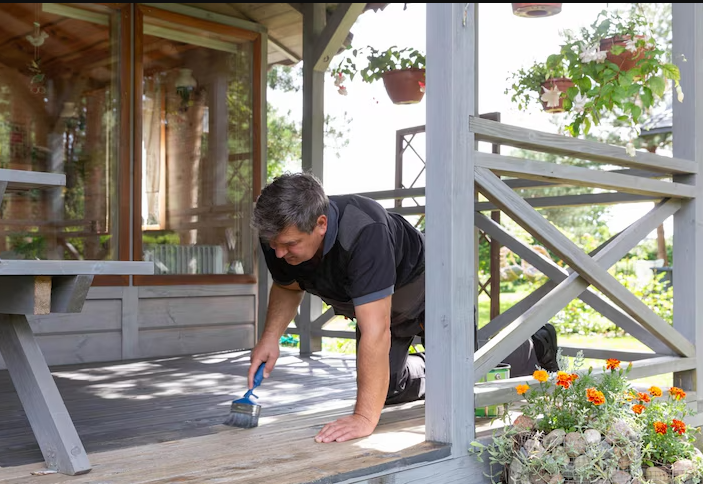How to Maintain Your Deck for Long-Lasting Beauty and Durability

A well-maintained deck enhances your home’s outdoor space, providing a comfortable area for relaxation and entertainment. But without proper care, exposure to the elements can take a toll, leading to fading, warping, and even structural damage. Whether your deck is made of wood or composite materials, regular maintenance is essential to keep it looking great and standing strong for years.
In this guide, we’ll walk you through the best practices for preserving your deck’s beauty and durability.
1. Regular Cleaning: The First Step to Longevity
Dirt, grime, and mold can build up on your deck over time. Without routine cleaning, these elements not only make the surface look dull but also contribute to long-term damage.
For best results, sweep your deck at least once a week to remove debris. Use a garden hose or pressure washer on a low setting to wash away stubborn dirt. If your deck has mildew or algae growth, mix warm water with mild soap or use a specialized deck cleaner. Scrub gently with a soft-bristle brush to prevent surface damage.
For composite decks, avoid harsh chemicals, as they may strip the material’s protective coating. Stick to manufacturer-approved cleaners to ensure the best results.
2. Inspect for Damage and Make Repairs Promptly
A small crack or loose board may not seem like a big issue at first, but neglecting minor damage can lead to more significant problems. Conduct a thorough inspection of your deck at least twice a year—ideally in spring and fall.
Look for:
- Loose or protruding nails
- Splitting or cracked boards
- Signs of rot or insect damage in wooden decks
- Rusting or weakened fasteners
- Wobbly railings
If you spot any issues, address them immediately. Replace damaged boards, tighten loose fasteners, and apply wood filler to small cracks before they expand.
3. Sealing and Staining: Protecting Against the Elements
Wood decks require sealing or staining to safeguard them from moisture, UV rays, and temperature fluctuations. Even pressure-treated wood isn’t entirely resistant to water damage.
Apply a high-quality sealant every 1–3 years, depending on your deck’s exposure to the elements. For expert guidance, refer to This Old House’s guide on deck sealing and staining, which provides professional insights on choosing the right products and techniques. Before sealing, ensure the surface is clean and completely dry. A water test can help determine if it’s time to reseal—sprinkle a few drops of water on the deck; if it absorbs quickly, your deck needs a fresh coat.
Stains not only enhance the deck’s color but also add an extra layer of protection. Choose a stain that offers both UV resistance and waterproofing to extend your deck’s lifespan.
4. Preventing Moisture Damage and Mold Growth
Water is one of the biggest threats to a deck’s longevity. If moisture lingers, it can lead to mold, mildew, and even wood rot.
Here’s how to minimize moisture damage:
- Ensure proper drainage around your deck by keeping gutters and downspouts clear.
- Avoid placing rugs or furniture directly on the deck for extended periods, as they can trap moisture.
- If your deck is in a shaded area, consider trimming nearby trees or bushes to allow more sunlight to dry out the wood.
Regularly check the area beneath the deck, especially if it’s a low-level structure, to make sure there’s no standing water.
5. Preventing Fading and Sun Damage
Sun exposure can cause wooden decks to fade and lose their vibrant color. Over time, UV rays break down wood fibers, making them more susceptible to cracking and splintering.
To minimize fading, apply a UV-protective stain or sealer. Additionally, consider using outdoor rugs or patio furniture with UV-resistant materials to shield high-traffic areas from excessive sun exposure.
If your deck has already faded, a high-quality stain can restore its natural beauty while adding a layer of protection.
6. Choosing the Right Deck Materials for Easy Maintenance
The type of material your deck is made from plays a significant role in how much maintenance it requires. While natural wood provides a classic look, it demands more upkeep compared to composite materials.
If you’re considering a new deck or a replacement, consulting professional deck builders can help you choose materials that balance beauty with durability. Composite and PVC decking options require minimal maintenance and resist moisture, insects, and fading better than traditional wood.
7. Seasonal Maintenance: Preparing for Weather Changes
Each season brings unique challenges for deck maintenance. Preparing your deck accordingly will keep it in top condition all year long.
Spring & Summer:
- Deep-clean the deck to remove winter grime.
- Inspect for any damage that may have occurred during cold months.
- Apply fresh sealant or stain if needed.
- Rearrange furniture to prevent uneven fading from the sun.
Fall & Winter:
- Clear fallen leaves and debris to prevent mold growth.
- Store or cover outdoor furniture to avoid weather damage.
- Avoid using salt or harsh de-icers in winter, as they can damage wood and metal fasteners. Instead, use sand for traction on icy surfaces.
8. Smart Furniture and Décor Choices for Deck Protection
While furniture and décor can enhance your deck’s aesthetics, they can also contribute to wear and tear if not managed properly. Heavy furniture can dent wood surfaces, and metal items may leave rust stains over time.
To protect your deck:
- Use furniture pads or rubber feet under chairs and tables.
- Move furniture around occasionally to prevent uneven wear.
- Choose outdoor rugs made from breathable materials to avoid trapping moisture.
9. Long-Term Investment: When to Consider a Deck Replacement
Even with diligent maintenance, decks don’t last forever. Wood decks typically last 10–20 years, while composite decks can exceed 25 years with proper care. If your deck shows extensive structural damage, sagging boards, or persistent mold and rot, it may be time to consider a replacement.
Upgrading to modern, low-maintenance materials can save time and money in the long run. If you’re unsure whether your deck needs repairs or a full replacement, a professional inspection from Boss Decks can provide clarity.
Conclusion
A deck is more than just an outdoor feature—it’s an extension of your home. By following these maintenance tips, you can preserve its beauty and durability for years to come. Regular cleaning, timely repairs, and protective treatments will keep your deck safe, sturdy, and visually appealing.
Investing time in upkeep now prevents costly repairs later. Whether you have a classic wooden deck or a modern composite one, proper care ensures that your outdoor space remains a welcoming retreat season after season.

The Ultimate Guide to Faster and More Accurate Invoice Processing

6 Tips To Unlock New Business Opportunities With My Aged Care Registration

The Hidden Business Power of Storytelling Through Books

Accelerating drug discovery through the DEL-ML-CS approach

AI in Marketing Is No Longer a Buzzword — It’s the Strategy

Master Strength and Conditioning with ASFA’s Expert Certification Program

Sling TV vs Fubo: Which IPTV Service Wins?

How to Find the Best Hydrogen Water Bottles: Features to Look For








